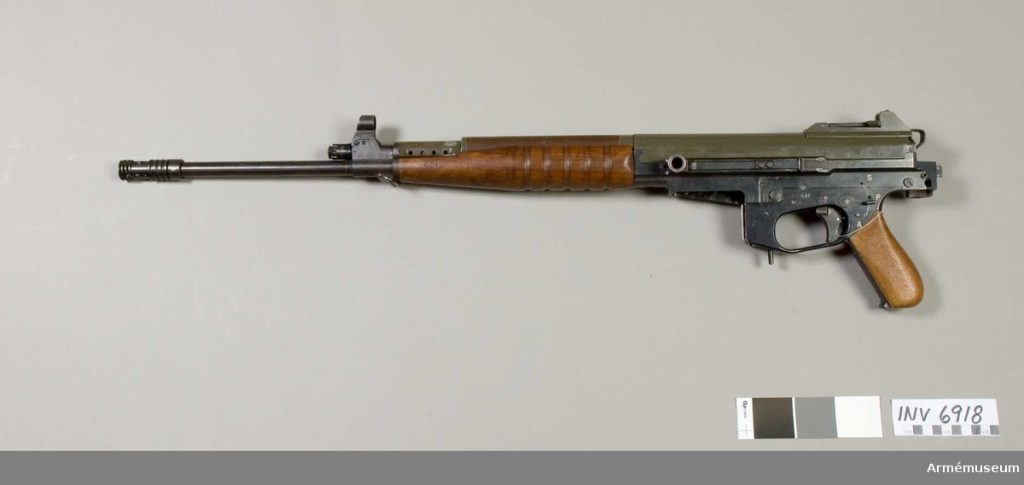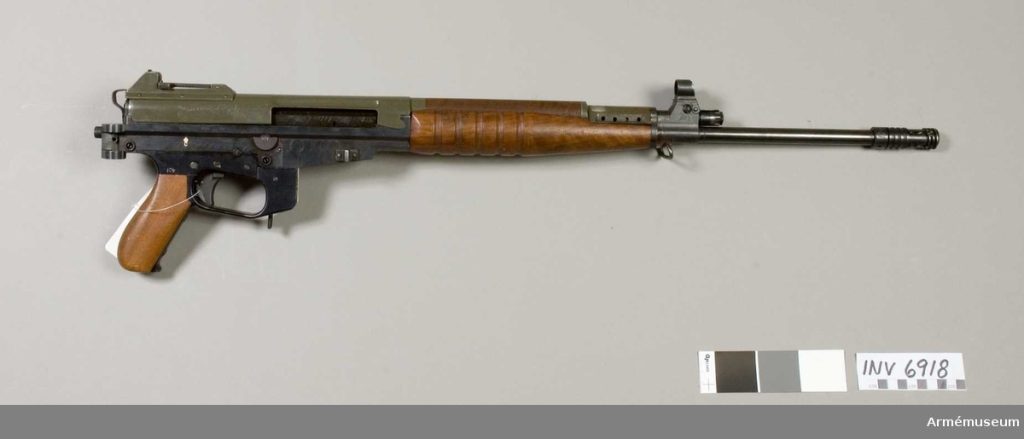Editor’s note: Edvin Lofthammer is a student as the Swedish Defense University writing a thesis on the adoption of the AK4 by the Swedish military. The following article is an interesting side note of Swedish development that did not fit into the scope of his thesis, but ought to be published nonetheless.
by Edvin Lofthammar
During the early Cold War, Sweden had a rapidly expanding military as a result of it’s neutral stance in the balance between the west and the east. In WW2, Sweden had been able to stay out of the conflict, but due to this there were some moments were they had to compromise on their hard-line neutrality in order to appease the major actors of the war. Infamously, Sweden allowed German soldiers to pass through the country via train, a number totaling around 2,140,000 soldiers between 1940 and 1943. After WW2, Sweden decided to invest large amounts of resources and money in both civilian and military defence, which formed what in Sweden is referred to as the Total Defence (Totalförsvaret). During WW2 Sweden had produced a lot of it’s own military hardware, and continued to do so into the Cold War. This included the Kulsprutepistol M/45 (known as “The Swedish K” abroad) and the Automatgevär M/42 (mostly know as the Ljungman abroad, pronounced Yung-Mann). When Sweden realized it had to update its standard issue infantry rifle in the early 60s, it was therefore only natural that a domestic design be submitted as well. This would be the AK GRAM.

The AK GRAM was an experimental gun designated as an Automatkarbin in Swedish nomenclature. This translates to Automatic Carbine, and is not synonymous with either the term Assault Rifle or Battle Rifle which are prominent in the English-speaking world. The “Automatic” in Automatic Carbine refers to it being a self-loading gun. A mainly fully automatic weapon would have the prefix “Kulsprute” (Bullet-Spewing). The Carbine part was simply because it was considered shorter than what would typically be considered a rifle. There is however some instances of Automatic Carbines being longer than Automatic Rifles. For example, the M-14 (which was also trialed by Sweden during the same time) was at this time designated an Automatic Carbine despite its total length being 1,126mm, which is longer than the German G-43 at 1115mm, which was considered an Automatic Rifle. The most accurate description of the AK GRAM in English-speaking circles would be Battle Rifle, as the gun was chambered in both 6.5 Swedish and 7.62 NATO.

The gun can trace its heritage back to the AG 42, as the AG 42 was modified to become another prototype Automatic Carbine intended for use with Swedish paratroopers. This gun first became known as the AK FM/57, and featured, among other things, a folding stock, pistol grip and removable 20 round box magazines. From this project (which never saw mass adoption) sprung the AK GRAM. It was originally designated AK m/W, named after its creator E.W. Wallberg who was an engineer at Sweden’s main firearms developer and manufacturer, Carl Gustaf Gevärsfaktori. It is however worth noting that Nils Lundin who was also an engineer at Carl Gustaf Gevärsfaktori is also credited with constructing the gun, and he has been credited with the construction of the mechanism as well. The gun would soon after the first rounds be renamed the AK GRAM. “GRAM” probably refers to the sword “Gram” which in nordic mythology was passed from Oden to Sigismund, and is most likely not an acronym.
The AK GRAM took a lot of details that were changed from the AG 42 when it was modified to become the AK FM/57, including integrating a piston in the previously direct gas impingement system for increased reliability, and it otherwise was very similar to the tilting bolt design on the AG 42. The gun was select fire, and weighed 4.35 kg (9.6lb) unloaded. The length without a flash hider (which was being designed when measurements were taken) was 1060mm, and with the folding stucked folded it was 800mm (31.5in). The barrel length was 520mm (20.5in). Rate of fire was around 650 RPM. The gun was constructed in both 6.5 Swedish and 7.62 NATO, and for the 6.5 Swedish version a curved magazine was designed.
It is more accurate to describe the AK GRAM as a distant derivative of the AG 42 more than anything else, since the gun was changed so much that it became doubtful whether or not they would be able to reuse any tooling from the AG 42. This was something that had previously been heralded as a benefit compared to the foreign designs competing with it, the main competitors being the HK G3 (which after quite a substantial amount of modification was accepted into service as the AK 4) and the FN FAL. The AK GRAM was continuously updated, but always lagged behind its competitors. In 1963 the final model was designated the AK FM/63 GRAM. This design also lagged behind the competition, and this was the point at which KATF (the Swedish ordinance department at the time) pulled the plug on the project and decided to concentrate on the G3 and FAL instead. The main issues that went unsolved throughout its lifetime was feeding and ejecting issues, something even the final version couldn’t alleviate in any acceptable amount. The gun never left the technical testing stages, and tactical testing wasn’t formally commenced.
In 1965 Sweden accepted and started to field the AK 4, and would continue to do so until it was replaced with a modified FN FNC designated the AK 5 in 1985. Sweden had a quite short timeframe of only 5 years to select and adopt its first Automatic Carbine, and this was even in the very first documents regarding the matter one of the key identifiable factors why a domestic option was dubious. KATF estimated a timeframe of 10-15 years to design an Automatic Carbine ready for mass production, which they compared to the 5-10 years required for a machinegun (kulspruta, referring to light, medium and heavy machineguns). Sweden had however managed to produce domestic designs for self-loading and fully automatic weapons before which had been quite succesful, mainly the Kulsprutepistol M/45 and the AG 42. Sweden also had a very succesful aircraft industry, which was producing cutting edge fighter jets like the J-35 Draken in a country of only 7.5 million people. Economically, Sweden was also in the middle of what is sometimes referred to as Rekordåren (the Record Years) which saw a rapid development in Swedish living standards and industry up until the oil crisis in 1973. These factors combined conceivably resulted in the will to atleast make an attempt at creating a domestic Automatic Carbine, despite the even then unsure possibilities of actually producing something usable. The projects justification in the tail end of its lifecycle was to provide Swedish engineers with valuable knowledge and experience in the construction and maintenance of Automatic Carbines. A completely Swedish Automatic Carbine, Assault Rifle or Battle Rifle design has since then not seen the light of day.